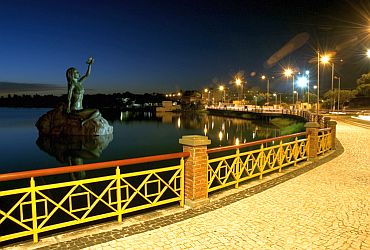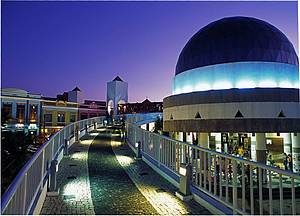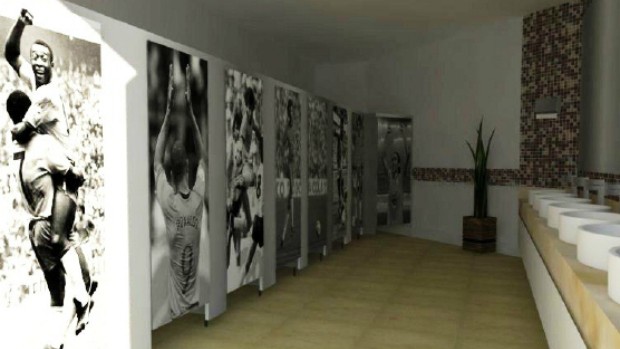
The first half of the 70s, by several factors, represents the inflection point, from which we found metropolisation de facto capital of Ceará. Until that time, we could still identify numerous aspects in its urban geography and customs that they referred to in Fortaleza provincial '30s post-war. It is obvious, however, that this is not a watertight division between the old and new city, since many projects that define modernity that were built in previous decades, as well as elements of provincialism still subsist after the 70s to the present day .
It was during the 70s that the growth of the city, which had over a million inhabitants, has become really visible. Mainly in terms of the urban and formal vertical space, Fortaleza was entitled to the status of metropolis and assumed the absolute primacy of the territory of Ceará, is the advanced process of urban expansion, is the enormous demographic concentration. This fact is due to the role it plays in Fortaleza contraction of the main administrative activities, commercial, industrial, port, social and cultural state.
The catchment area of Fortaleza, according to the IBGE survey 1972, has 52 centers, covering an area of 400 square kilometers, with a total population of about seven million inhabitants. Thus comprises the northern half of the states of Maranhão, Piauí and the entire state of Ceará.
Led by the city and devoid of popular participation, Fortaleza passes to enhance urban planning. It discusses the transformation of Fortaleza in regional metropolis and its envelope area in the metropolitan area. The vertical momentum suffers in the east (Aldeota), making this sector the biggest strength of the city's real estate.
According to Professor Borzacchiello José da Silva, "The search for new spaces by the bourgeoisie who resided near the downtown area resulted in marked changes in the city and overvaluation of some neighborhoods, like Aldeota, Meireles, Praia de Iracema, Papicu, district Fatima and others. The Aldeota is undoubtedly the most valued neighborhood of the city to be the favorite of the bourgeoisie and upper middle class. So has the best care infrastructure of urban services, trade and other equipment. During the 1970s, early in the process of vertical outside the central area, small apartment buildings were built in Aldeota. The construction of luxury buildings with large apartments, replacing the large residences, took place from another time.

Personal Ceará
In the late '60s, in times of dictatorship and repression, a group of artists attending cultural events in the Faculty of Architecture of the UFC and met regularly in Bar Anísio on Avenida Beira-Mar, beachfront of Fortaleza. There, almost every night, until dawn, they produced music, poetry, theater, sharing dreams and songs.
And there were pioneers Augusto Bridges, Petruchio Maia, Roger Rodger, Fausto Nilo, Belchior, Ednardo, Fagner, Brandão, Teti, Yeda Estergilda, Gilmar de Carvalho, Ricardo Bezerra, Alba Paiva, Marli Vasconcelos, Tanya Araújo, Xica, Olga Paiva Pepe, Cirino, Amelia, Jorge Mello, Antonio Carlos, Claudio Pereira, Sérgio Pinheiro, Wilson Ibiapina Guto Benevides, Mino, and many others in a good class of more than 80 names, working in various forms of artistic expression.
In the early 70s many of them left the Ceará bound for Rio de Janeiro, Sao Paulo and Brasilia. All we wanted was to show their music and earn a place in the sun. Ednardo, Fagner and Belchior, the main songwriters of the group, began to walk the path that would lead them to success in the southern lands. Thus emerged, the group is called the history of our popular song, such as "Personal Ceará."
The starting of the production of this group was "My body my packaging all spent on the trip - Personal Ceará", album produced by Continental label in 1973, containing songs performed by Ednardo, Rodger Rogério and Teti, artists little known, but from hence, lassoed to Brazil, the music and the composers Ceará.
On condition that the group's leader, was the composer and singer best Ednardo who translated his love of Fortaleza. According to Pedro Rogério,'' 'Terral' and 'the Seaside' - both compositions Ednardo - two songs that stood out in hard-March Personal Ceará, are true hymns, composition of a passionate assumed that, as a son need to prove the sincerity of your feelings, declares his love for the Mother City at the same time, feeling that is already mature enough, let yourself be seduced by other women, other cities, never free itself from the womb. "
In Ceará, this generation of artists, musicians, composers and singers, after more than 40 years of its inception, has yet to be surpassed, either in quality or quantity of his artistic production.












 Personal Ceará
Personal Ceará

